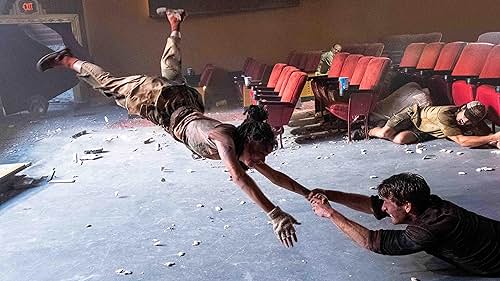“You don’t have to trust me as long as you can persuade me to trust you.”– Sam Spade
After an extended length of time, it gives me no small amount of delight to return to my films feature here at dear PopCultHQ. This month’s picks come courtesy of the good folks at Warner Bros. and the fine firm of Falkowitz PR. To kick off this month’s features is a movie still heralded as one of the greatest and arguably the finest examples of film noir as we know it. Or rather, as Roger Ebert once said, “It put down the foundations for that native American genre of mean streets, knife-edged heroes, dark shadows, and tough dames.”
Yes, that king among detective stories and the feature propelled Humphrey Bogart into the history books The Maltese Falcon.
It has been 82 years since its release. Yet, its brilliant plot, fantastic cast, and wonderful directing by the legendary John Huston continue to put it in the highest esteem for noir films of all time, ranked third by Rotten Tomatoes and fourth by The Independent.
But what is it about this movie that continues to make it memorable to this day? This is where the rubber meets the road, my fellow cinephiles. I invite you to join me on the journey of exploring the three elements mentioned above and why they blended into a cocktail of pure motion picture bliss.
The Plot
Right, to kick the ball down toward the goal, let’s examine the plot, script, story, or whatever you want to call it. It isn’t just the tale of Sam’s journey to get out of this madcap race for the Falcon alive in one piece that matters; it is the staying power of The Maltese Falcon overall.

First written and serialized in five parts by Dashiell Hammett in Black Mask Magazine from 1929 to 1930, and then published as a novel in 1930, Hammett was already a household name thanks to previous works Red Harvest (which introduced another well-known detective in the form of The Continental Op) and The Dain Curse. But it is here, with the creation of Sam Spade, that the archetypal private detective is given a personality and a shape. Keen awareness when it comes to searching out clues, cold detachment from the world, stark lack of sentimentality, and a dogged attitude towards the pursuit of ‘justice’ are all character traits that can be found in Spade. However, he is wholly original, and according to Hammett, “He is a dream man in the sense that he is what most of the private detectives I worked with would like to have been, and, in their cockier moments, thought they approached.” (The Maltese Falcon introduction, 1934 edition)
Another thing to consider is that before publication, no one had ever quite written a mystery novel that could compare. The best way to sum it all up is the following quote from the National Endowment for the Arts: “Hammett’s clean prose and sharp ear for dialogue produced an exceedingly readable novel with enough twists to keep the reader turning the pages in search of clues.”
In short, Hammett and his work are brilliant, absolutely brilliant. Now, let’s move on to the next aspect of this ribald tale of greed, murder, and mayhem.
The Cast

Upon its release in 1930, Maltese Falcon became a favorite amongst readers and mystery fans and was adapted for cinema in 1931 and again in 1936. However, neither of the previous versions merits any mention aside from setting the precedent of not hitting the mark in taking the novel and putting it on the big screen. The second version isn’t even a faithful retelling. All the names are different; the object that everyone is willing to kill for is changed from a jewel-encrusted falcon statuette to a ram’s horn supposedly filled with gems. Its title was ‘Satan Met a Lady.’ Just thinking about it makes my brain itch; not even Bette Davis, who portrayed femme-fatal Valerie Purvis, would later call it junk.
No, what makes the cast of the 1941 version so brilliant is how all of their personalities mesh together on camera. Humphrey Bogart projected what would become his trademark quiet tough guy act while also embodying that steely determination that has become a benchmark for all PI’s of the noir genre. Then we have Mary Astor as Brigid O’Shaughnessy, a lady who weaves so many seemingly clever webs of deceit, yet in the end, meets defeat when it is all wrapped up nice and neat. And finally, Peter Lorre as Joel Cairo and Sydney Greenstreet as Kasper Gutman. These two are so slimy and scummy as far as criminals go; they practically deserve each other. Both want the Falcon, and both are willing to bribe for it and facilitate murder as well to get what they want. When all four figures share the camera, the clash of personalities and performances is downright dynamite.
One thing to remember here is that Bogart, in particular, had been acting for quite some time when he stepped into Sam Spade’s shoes. Heck, I’ve seen a few of his earlier works, and he does fine in them, but the comparison of where he was as an actor to what he became boils down to comparing apples to oranges. He nails it here and would continue do so in his subsequent career. Part of the success here can be attributed to John Houston, who would become a smash in the film biz thanks to The Maltese Falcon.
The Director

John Houston is a legend, both as an actor and as a director. It still shocks me that this was his breakout work sitting in the director’s chair, especially given his later works like Key Largo and The African Queen, which also featured Bogart in leading roles.
Huston also kept the adaptation more or less faithful to the book, using the bulk of the original dialogue and ensuring the script flowed smoothly like its literary counterpart. If you think I am pulling your leg on that one, just read the book (it is a delight and a real page-turner), and afterward, watch the movie, and you’ll see exactly what I mean.
His choice of closeups to capture actors’ facial expressions is a tool that is synonymous with noir films. The energy, emotions, and even the movie’s pacing all benefit from using closeups to give audiences a real ‘window into the soul’ with Bogart, Astor, and the other major players. Especially as the story wraps up, when the pieces start falling into place (and things start falling apart for the crooks), we get some real intensity from Sam Spade, Gutman, and Brigid’s characters.
All that is thanks to having someone like John Houston running things, and all the other movies he worked on over the years benefited from his working on Maltese Falcon and cutting his teeth in a big way to kick-start his directorial career.
Conclusion
Noir has always been one of my favorite choices when it comes to movies that I love the best. There is something about the cases, full of twists and turns and all the varying flavors of humanity that get brought to life through the casts. The Maltese Falcon will always remain in my top five favorite picks for the genre and would make a delightful Christmas present or stocking stuffer for a loved one this holiday season.
Make a point to sit down and watch this flick at some point. Even if you are not a fan of detective fiction, this one may change your mind by the end of the story.
5 out of 5 stars




